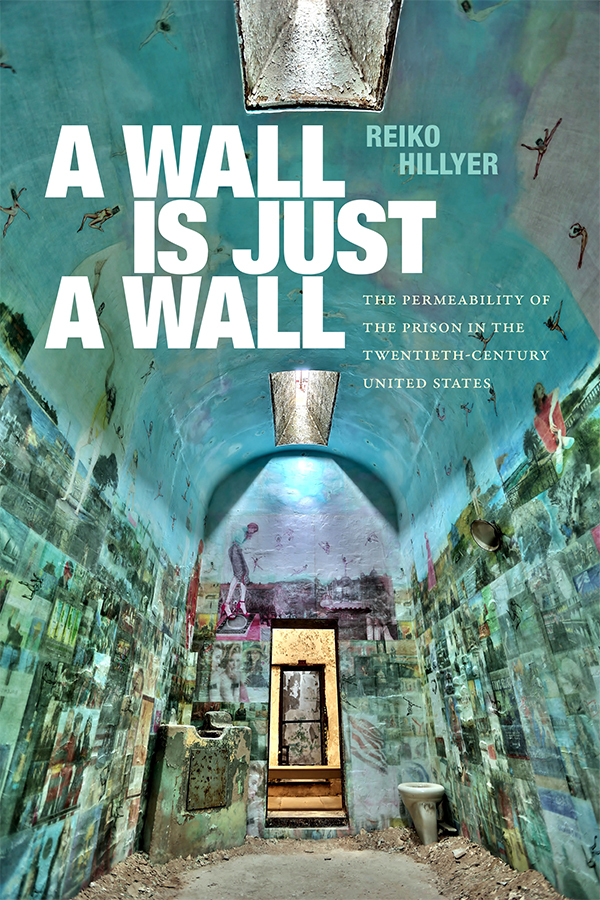Since 2012 I have taught a college history class at Columbia River Correctional Institution in Portland, Oregon. Undergraduate students in the course are from Lewis & Clark College, where I am an associate professor, and the incarcerated students are confined at CRCI, a minimum-security men’s facility that houses both people serving shorter sentences and those at the end of very long sentences.
Year after year, incarcerated students comment that our classroom is an emancipatory space. In the class they are allowed to use their minds, express their thoughts, expand their knowledge and skills, and earn college credit. Even more significantly, their experiences as incarcerated people are cherished as valuable wisdom alongside and against the scholarship we read. Because the outside students represent the broader public from which the incarcerated students have been cast out, their attention, their listening, and their acceptance temporarily ameliorate a sense of exile.
Over the years of teaching the course, I came to wonder as a historian if prison walls had always been so impenetrable. When researching a 1968 prison strike at the Virginia State Penitentiary, I noticed that incarcerated musicians were able to leave the penitentiary to give concerts and several other incarcerated people were granted furloughs to participate in high school chess tournaments well into the 1970s. Going back even further, Norfolk Prison in Massachusetts was founded in 1927 as a “model prison community” whose stated mission was to keep incarcerated people engaged with, rather than removed from, the outside world. While Malcolm X was incarcerated at Norfolk from 1948 to 1952, he participated in the Norfolk Prison Debating Society and debated university teams. The Wallkill Correctional Facility in New York State was constructed in 1932 in a college campus style with no walls or fences; when eight incarcerated people escaped one year later, the New York Times declared, “Wallkill Prison without Walls a Success; Only Eight Break Trust in an Air of Freedom.”
In other words, prison walls have not always been impermeable. What changed, and did that change contribute to the rise of mass incarceration? And, if so, is there an older discourse about permeability of prison walls that could help us to undo mass incarceration?
At a time when commutations, furloughs, and conjugal visits are rare, and prisons are often located in rural areas—designed expressly for the purpose of achieving higher degrees of confinement and social isolation—it is important to recognize that the separation of incarcerated people from free society was not always as absolute as it is today. In order to understand the nature, assumptions, and consequences of mass incarceration, we must grapple with the increasingly permanent exclusion of incarcerated people from society as both cause and consequence of punitive policies that are relatively recent. Prison walls began to thicken and harden in the post–World War II period, but even until the 1990s U.S. prisons were relatively permeable.
Incarcerated people were regularly granted furloughs, released from prison for Christmas holidays, to visit sick relatives, to play concerts, and to participate in professional boxing matches. Likewise, many states had provisions for conjugal visits so that incarcerated people’s romantic partners as well as family could occasionally come stay overnight in the prison. Mississippi, for example, whose penal practices were infamous for their brutality, was the first state to provide conjugal visits to incarcerated people. Commutations of long and indeterminate sentences were also the rule rather than the exception, even in the South at the height of Jim Crow.
Although it is hard to believe now, these practices often enjoyed the support of state actors and prison administrators. In the case of furloughs, for example, corrections administrators and social scientists, along with governors of both parties, supported the practice, but they found themselves at odds with those in law enforcement. As clemency became politicized and governors were increasingly reluctant to grant it, prison wardens vocally defended discretionary release of incarcerated people who, on the basis of their firsthand knowledge, presented no threat. The decline of both furloughs and clemency indicates that shrinking faith in official discretion was accompanied by a tendency to dismiss the expertise of corrections professionals, who, because they were engaged with incarcerated people on a daily basis, had concrete reasons for advocating policies that politicians rejected for motives of their own.
More from our decarceral brainstorm
Every week, Inquest aims to bring you insights from people thinking through and working for a world without mass incarceration.
Sign up for our newsletter for the latest.
Newsletter
Interestingly, uses of furloughs and conjugal visits didn’t always track perfectly with the rise of tough-on-crime politics. Concurrent with conservative backlash to the civil rights movement, prison officials continued to experiment with practices that facilitated movement across prison walls. Since conjugal visits and furloughs could serve as mechanisms of control, they were popularized at the very moment when racialized fearmongering about crime in the streets inspired intensified policing and harsher sentencing. At this contradictory juncture, social scientists, politicians, journalists, and corrections administrators advocated more interchange between the prison and the free world, fashioning a common sense that seems radical today. The crisis produced by prison overcrowding also disrupts neat periodization. During the 1980s, a decade usually associated with the “prison boom,” Mississippi and other states did not respond to overcrowding by expanding their prison systems but turned to mass clemencies as a vehicle to reduce their prison populations.
By the 1990s, however, thanks to the moral panics fomented by politicians, the insinuation of victim impact statements into the sentencing process, and the belief that habitual criminals were gaining rights at the expense of law-abiding citizens, incarcerated people began to lose hard-won channels to the outside world and their customary expectation of eventual release. Tropes of “revolving door prisons” and “country club prisons” drew upon the anti-welfare rhetoric of the time, helping to undergird a movement that critics call penal harm, which justified not only longer sentences but harsher conditions. Just as the anti-welfare movement suggested a zero-sum understanding of government spending so that whatever benefits the racialized poor received were imagined as coming at the expense of employed taxpayers, the penal harm movement endorsed the termination of conjugal visits and furloughs as indulgent luxuries, the putative “pink Cadillacs” of prison life.
By the 1990s, those convicted of crimes came increasingly to suffer perpetual exclusion, cast by fearmongering politics as fundamentally other, fixed in an identity outside of society’s moral circle. The increasingly permanent exile of incarcerated people is connected to Jonathan Simon’s observation that recent decades have seen the correctional subject more tightly tethered to his crime. This shift is documented in the changing eligibility standards for furloughs in Arizona: in 1988, for the first time, furlough eligibility was based on the class and nature of the original offense rather than one’s institutional record. The rigid logics of risk management not only chain incarcerated people to their past but, like a kind of postmodern phrenology, purport to determine the future.
According to Richard Berk, who researches predictive policing and teaches criminology at the University of Pennsylvania, developments in algorithmic policing and data science make it possible to “calculate the likelihood that someone will engage in criminal activity before they are born” (a turn of phrase documented in Craig Atkinson’s documentary Do Not Resist). And under this new common sense about the nature of crime—that it is intrinsic to character—the public’s faith in prison’s efficacy relies not on the institution’s capacity to rehabilitate but on its ability to keep criminals behind thick walls.
For their part, incarcerated people have resisted the tightened constraints on their lives. When clemencies dried up and furloughs ended, incarcerated people experienced devastating losses. Despite the fact that their original crimes have become permanent brands, incarcerated people struggle to place themselves in history, both by testifying to their own transformation and by tracking the law’s transformation over time. Having complied with the customary conditions of their confinement in order to make meaning as well as earn privileges and mercy, incarcerated people developed a collective consciousness of their just desserts and critiqued the prison against its own claims and the politicians who seemed to be playing games with their lives.
While many incarcerated people had denounced furloughs and conjugal visits as bribes, others accepted them—eagerly or begrudgingly—as a means of immediate improvement in the conditions of their lives. Practices such as granting clemency, conjugal visits, and furloughs were the objects of collective mobilization by incarcerated people and claimed as an entitlement. By agitating for such possibilities, incarcerated people revealed their strategies for survival as well as both individual and collective betterment. At the same time, because the practices in question were framed by prison administrators as privileges rather than rights, they could be taken away, exposing the ultimate power of the prison.
Often, scholars and activists now warn that making prison kinder only legitimates it, and have demonstrated that past reforms have only led to a strengthening of the carceral state. And given the growth of the carceral state, it is tempting to regard those advocating for a return of furloughs and conjugal visits as disingenuous, cynical, or hopelessly naive. But the assumptions that undergirded these practices reveal a moment when the permeability of the prison was interpreted as a stage in its dissolution. These assumptions—the belief that incarceration was almost always temporary, the idea that most people who were incarcerated should have ways to sustain their relationships with loved ones as well as the public, the trust that even those convicted of violent crimes could and should move about unescorted outside prison, and the faith that people who broke the law need not be perpetually ostracized for their crime and instead should be shown mercy—were as normative then as they are anathema now.
If challenging hegemonic institutions such as the prison requires a fundamental change in consciousness, we must time travel to those moments when today’s assumptions were not common sense. According to Ruth Wilson Gilmore and Craig Gilmore, “the ways people think about the world, and understand themselves in it, define in large part what they do to endure or change the world.” I share Jonathan Simon’s view: “To go forward, we must look back. Along with tens of thousands of individuals, mass incarceration has also swept away a landscape of criminological ideas and projects that, as of the late 1970s, was a thriving field of intense intellectual competition.” Looking back at these ideas and practices can allow us to “enter a kind of literary Pompeii in which the authors have been captured in positions of struggle relevant to the fault lines of the moment, oblivious to the lava flow about to overtake them.” The fundamental idea that public safety could be best ensured by making the prison more permeable is one of those pillars of thought buried under the lava flow. Recent writing follows the extension of the carceral state into so-called free territory, but the historic permeability of the prison holds possibilities for freedom as well. Most fundamentally, we must reckon with the reality that people—even those who have committed horrible acts of violence—change over time. There are people currently incarcerated who remember when this was common sense.
Thus, creating possibilities to collapse the boundaries between inside and outside is a practice of refusing the ideological and material boundaries that produce disposable and punishable categories of people. The practice of encounter between inside and outside cuts through media sensationalism, political posturing, fearmongering, and panic. Through “getting close,” we embody the possibility that things could be otherwise. As political philosopher Lisa Guenther has said of building bridges between inside and outside prison: “This is what abolition looks like . . . the creation of new ways of thinking, seeing, feeling, speaking, and experiencing a world that is shared in common with all other human . . . beings. So, coming together is a small act of resistance at the scene of the ‘crime’ itself.”
Radical change must be ushered and experienced in steps that are imaginable in order to change people’s views of what is possible. By providing wedges that literally open the prison doors, we can overcome the panic with which we have been infected and make the unthinkable thinkable. Eye to eye, we can mend the social fabric. We must confront the fact that prison walls were made. And, in the words of Frederick Douglass, “What man can make, man can unmake.”
Excerpted from A Wall is Just a Wall: The Permeability of the Prison in the Twentieth-Century United States by Reiko Hillyer. Copyright Duke University Press © 2024. All rights reserved.
Image: Artem Shuba/Unsplash


